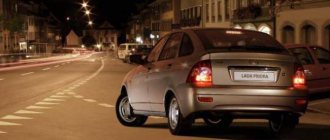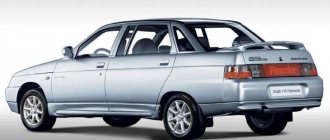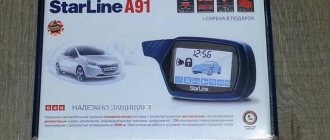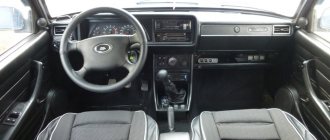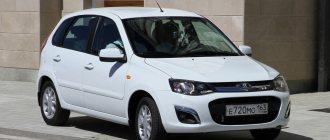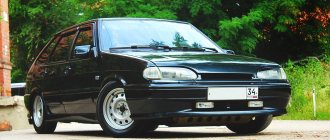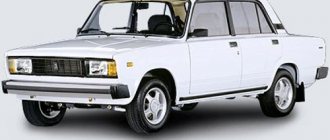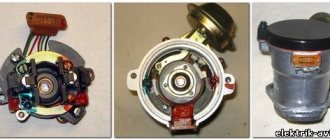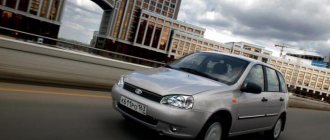During the heyday of the domestic automobile industry (the mid-70s of the last century), leading automakers talked about the advantages of front-wheel drive cars, saying that they were lighter, more compact, and more economical. However, the IZh automobile plant did not agree with this and in 1979 presented a prototype of the rear-wheel drive Izh-2126 (“T series”), which embodied the most modern technologies at that time. After the premiere, the model was steadily improved, and finally in 2001 the Izh-2126 “Oda” was presented to the public.
Taking into account the experience and failures of previous generations, the new Izh-2126 “Oda” was distinguished by a modest, but not devoid of a sense of style, exterior, compact dimensions (4068x1650x1450 mm), low weight (curb weight - 980 kg), relatively decent ground clearance (clearance - 155 mm ), in addition, the hatchback turned out to be easy to operate and, what is most attractive, inexpensive.
Design
Externally, the car is radically different from its predecessor, the Combi. Thus, the car received a more streamlined and aerodynamic body. By the way, to reduce the air resistance coefficient, IZh engineers strongly tilted the windshield. And the side windows are made curved. This decision also made it possible to slightly expand the free space in the cabin.
Of course, by today's standards, the design of the car is significantly outdated. And there are only a few of these cars left. The fact is that the body of the IZH-2126 “ODA” was prone to rust. After just a couple of years of operation, serious pockets of corrosion appeared on the metal. Today, it is almost impossible to find a whole and not rotten specimen.
Dimensions, ground clearance
The body dimensions are almost identical to the Oda. Thus, the length of the all-wheel drive Izh is 4.07 meters, width 1.65 meters, height 1.45 meters. At the same time, the IZH-2126 060 4×4 was a very light car. Its curb weight is only 980 kilograms. In terms of ground clearance, the body has been raised 6 centimeters. But the suspension elements (including axles) remained at the same level. Therefore, the fair ground clearance was only 15.5 centimeters. But the lifting angles have increased significantly due to the high location of the bumpers. The machine copes well with loose snow and wet primers.
Salon
The interior design is quite modern for 1990s. However, by the 2000s it was noticeably outdated. Thus, the car has a simple three-spoke steering wheel and a dial instrument panel. Note that there was very little space in the cabin. In order to somehow expand the volume, engineers had to move the engine and rear gearbox in the IZH-2126 ODA to the right side. Thus, the space in the pedal assembly has increased and overall ergonomics have improved.
What are the downsides to the interior of this car? Owner reviews note the poor quality of sound insulation. There is also quite hard plastic inside and shapeless seats. You get tired quickly in this car, the owners note. On the other hand, it is worth understanding that IL “ODA” is, in fact, a development of the 1980s.
"Oda": four-wheel drive and other modifications
And finally, we further produced the Izh “Oda” 4x4 car - this is a crossover, which is a descendant of the “Muscovites” and “Pobed” with all-wheel drive.
The transmission system was installed from Niva. In this version, the sound insulation of the cabin has been significantly improved. Several more cars were subsequently created on the basis of the Oda. Thus, the latest mass-produced car is the Izh “Oda Fabula” 4x4 station wagon with rear-wheel drive and all-wheel drive. A luxury version of the popular Nika hatchback was also produced.
The production of "Oda" was launched in small volumes, finding demand among ordinary people who prefer to repair the car with their own hands. The car was able to compete with classic VAZ models. People bought Izh "Oda" 4x4 cars. Reviews about them then were only positive - no one had ever done this in Russia.
Specifications
IZH-2126 "ODA" was equipped with different engines. But they were all gasoline. So, initially the IZH-2126 “ODA” car was equipped with an engine from the “six” - VAZ-2106. With a volume of 1567 cubic centimeters, this engine developed 74 horsepower. Torque – 121 Nm.
Next on the list is UZAM-331. This engine develops power of 86 horsepower with a volume of 1.7 liters. Torque is 129 Nm. Also, this car was equipped with a Niva engine with a power of 79 horsepower and a volume of 1.8 liters. True, its torque was lower than that of UZAM-331 - 127 Nm. The most powerful in the line is the UZAM-3320 power unit. This engine with a volume of 2 liters develops a power of 115 horsepower. Torque – 165 Nm.
As for the dynamics of acceleration, the car reached the first hundred in 15-18 seconds, depending on the installed engine. The maximum speed is 155 kilometers per hour. As reviews note, this car is not at all intended for dynamic driving. Although there are some owners who modify these engines to achieve faster acceleration.
A car's fuel consumption depends on its speed. The most economical mode is 90 kilometers per hour. At this speed, the car spends about 6.5-8 liters, depending on the engine. But at 120 kilometers per hour, the car already consumes more than 10 liters. In the city, consumption is approximately the same - from 9.8 to 11 liters per 100 kilometers.
IZH in winter
Surprisingly, this car easily survives the winter. The all-wheel drive car starts easily in cold weather of -25 degrees. At the same time, the engine warms up quickly. The stove is just as warm. Unlike VAZ, owners do not have problems with it.
Few people have repaired it over the many years of operation. The stove is one of the most important advantages of this model. This car does not cool down even while driving. At 25 degrees below zero, the thermostat does its job perfectly - there is no need to additionally cover the radiator with cardboard or do anything else. The cooling system here is very reliable.
Chassis
At the front of the car, a lever-spring independent suspension is used. Its design is similar to that used on the 412 Moskvich. The rear also has a lever-spring design, but on A-arms. However, later this design was abandoned, and the rear suspension was similar to that used on the Zhiguli.
A little later, engineers developed two versions of the front chassis with MacPherson struts. In the first case, these were triangular lower arms, in the second, straight arms with a stabilizer bar. It was the second scheme that went into production.
But the experiments with the chassis did not end there. The factory also offered several more rear suspension options with different geometries:
The steering is of the worm type. This system was soon replaced by a more modern rack. But the design of the brakes has not undergone any changes over the entire 15 years of production. Thus, the car used a dual-circuit hydraulic system with diagonal separation of the circuits. There were disk mechanisms in front, and drum mechanisms in the back.
Let's sum it up
So, we found out what this car is. Among its advantages it is worth noting:
But at the same time, the car has a lot of shortcomings. This is an outdated design, a rotting body, a lack of any safety, poor dynamics and constant breakdowns during operation. Therefore, you should think carefully before purchasing this car.
Car IZH-2126 “ODA”: photo, review, technical characteristics on News4Auto.ru.
Our life consists of everyday little things that in one way or another affect our well-being, mood and productivity. I didn’t get enough sleep - my head hurts; I drank coffee to improve the situation and cheer myself up - I became irritable. I really want to foresee everything, but I just can’t. Moreover, everyone around, as usual, gives advice: gluten in bread - don’t go near it, it will kill you; A chocolate bar in your pocket is a direct path to tooth loss. We collect the most popular questions about health, nutrition, diseases and give answers to them that will allow you to better understand what is good for your health.
History of creation
In 1991, Izhevsk Automobile Plant began mass production of a new rear-wheel drive small-class passenger car with a hatchback body, which was named IZH-2126 “Oda” . This was the first hatchback produced by the car plant , after the IZH-13 “Start” prototype, development of which began back in 1968.
IZH-2126 "Oda" was truly a people's car, it was quite comfortable for those times, its cabin easily accommodates five people, anatomical seats that are adjustable in length and angle of inclination allow you to drive for a long time without feeling a stiff back, and the level of noise insulation complied with European standards. It was easy to operate and, importantly, a relatively inexpensive car.
Work on the IZH-2126 car has been going on since 1979, when one of the first prototypes of the car, the so-called T-series . The car, despite its compact appearance, had a roomy interior for those times, which could be compared with the interior of the Volga (at least in length).
Externally, the experimentally produced cars bore little resemblance to the production model. The headlights were round in a black rectangular housing with turn signals at the corners of the front end.
The prototype received a modernized gearbox from the 412 Moskvich, to which a fifth gear was added, and instead of a rocker drive, a lever located directly on the crankcase was installed. The car also received rack and pinion steering and a dual-circuit braking system. The brake system had a diagonal distribution of contours, i.e. The front left wheel and the rear right wheel braked and vice versa. This made it possible to stop the car if one of the brake system drive circuits failed at the expense of the second, although with less efficiency.
In the process of working on the T-series of the IZH-2126 car, IzhAvto engineers used almost all the latest technologies available at that time; for the first time, the body was calculated on a computer and blown in a wind tunnel. But this prototype was not allowed to enter serial production, since during state tests a number of shortcomings were identified in this prototype that needed to be eliminated.
In 1980, a new batch of modified prototypes was released - “Series 0”, which bore their own name, not indicated anywhere - “Orbit”. This series had quite significant differences compared to its predecessor. The front part became more streamlined, the headlights became twin in the likeness of the VAZ-2106, and the turn signals moved from the corners of the front end to the bumper. In addition, the angle of the rear window was changed, making it less splashy.
Next came the prototypes of the 02 and 03 series, which were sent to France, where IzhAvto specialists, together with Renault specialists, finalized the appearance of the body, optics, bumpers and interior. “Series 04” already had an appearance similar to the production model, it passed state tests and was recommended for mass production. However, between the 4th series and the production model, there was another batch of prototypes, the so-called “Series 05”. This model, as well as subsequently the serial one, was equipped with new headlights, front disc brakes, a heater radiator, a rear-view mirror located in the cabin, a steering wheel from a VAZ-2108 car, a driveline clutch from a VAZ-2106 car, an instrument panel combination from 41 Moskvich and rear brake pads from 412.
In 2005, 15 years after the release of the first production car, the IZH-2126 “Oda” was discontinued, and this was the end of its history.
This is interesting: How to find out what engine size is on a VAZ 2106
